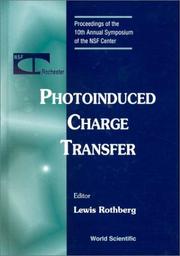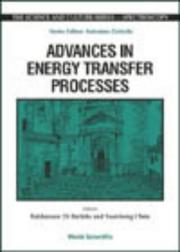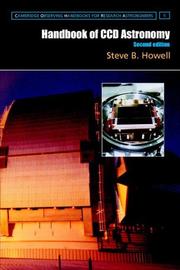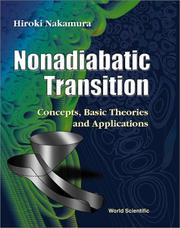| Listing 1 - 10 of 33 | << page >> |
Sort by
|
Book
Year: 2013 Publisher: KIT Scientific Publishing
Abstract | Keywords | Export | Availability | Bookmark
 Loading...
Loading...Choose an application
- Reference Manager
- EndNote
- RefWorks (Direct export to RefWorks)
Charge transport and charge transfer (CT) capabilities of deoxyribonucleic acid (DNA) are investigated. A QM/MM multi-scale framework is applied to calculate the CT capabilities of DNA under conditions resembling the experimental setup. The simulations are able to explain and predict the outcome of experiments and therefore make suggestions in advance. Based on the findings, suitable DNA sequences can be opted for the design of DNA-based devices as nano-scale electronic elements.
Charge Transfer --- Molecular Dynamics --- Charge Transport --- Quantum Mechanics --- DNA

ISBN: 9812793291 9789812793294 9810242670 9789810242671 Year: 2000 Publisher: Singapore New Jersey World Scientific
Abstract | Keywords | Export | Availability | Bookmark
 Loading...
Loading...Choose an application
- Reference Manager
- EndNote
- RefWorks (Direct export to RefWorks)
Photoinduced charge transfer constitutes the scientific basis of photography, electrophotography and many biological processes. In addition, the science of charge photogeneration and transport in organic materials will be the basis of future generations of optoelectronic devices. This volume summarizes the state of the art in photoinduced charge transfer.
Charge transfer --- Photochemistry --- Transfer, Charge --- Collisions (Nuclear physics) --- Electron donor-acceptor complexes --- Electrons --- Ion exchange --- Mass transfer
Book
ISBN: 303813094X 9783038130949 3908158028 9783908158028 Year: 2006 Publisher: Switzerland
Abstract | Keywords | Export | Availability | Bookmark
 Loading...
Loading...Choose an application
- Reference Manager
- EndNote
- RefWorks (Direct export to RefWorks)
This collection presents 26 papers. Altogether, the collection offers a wealth of up-to-date information on Mass and Charge Transport in Inorganic Materials.
Mass transfer --- Charge transfer --- Inorganic compounds --- Transfer, Charge --- Collisions (Nuclear physics) --- Electron donor-acceptor complexes --- Electrons --- Ion exchange

ISBN: 1281956538 9786611956530 981281096X 9789812810960 9789810247287 9810247281 Year: 2001 Publisher: River Edge, NJ World Scientific
Abstract | Keywords | Export | Availability | Bookmark
 Loading...
Loading...Choose an application
- Reference Manager
- EndNote
- RefWorks (Direct export to RefWorks)
This book describes advances in both experimental and theoretical treatments in the field of energy transfer processes that are relevant to various fields, such as spectroscopy, laser technology, phosphors, artificial solar energy conversion, and photobiology. It presents the principles and available techniques through specific examples. In addition, it examines current and possible applications, including the most recent developments, and projects future advances and research possibilities in the field.
Contents:
- Fundamental Interactions Leading to Energy Transfer (B Di
Energy transfer --- Charge transfer --- Electronic excitation --- Excitation, Electronic --- Electrons --- Exciton theory --- Transfer, Charge --- Collisions (Nuclear physics) --- Electron donor-acceptor complexes --- Ion exchange --- Mass transfer
Book
Abstract | Keywords | Export | Availability | Bookmark
 Loading...
Loading...Choose an application
- Reference Manager
- EndNote
- RefWorks (Direct export to RefWorks)
This eBook is a collection of articles from a Frontiers Research Topic. Frontiers Research Topics are very popular trademarks of the Frontiers Journals Series: they are collections of at least ten articles, all centered on a particular subject. With their unique mix of varied contributions from Original Research to Review Articles, Frontiers Research Topics unify the most influential researchers, the latest key findings and historical advances in a hot research area! Find out more on how to host your own Frontiers Research Topic or contribute to one as an author by contacting the Frontiers Editorial Office: frontiersin.org/about/contact

ISBN: 9780521617628 9780521852159 0521617626 0521852153 9780511807909 9780511161780 0511161786 0511161050 9780511161056 0511807902 0511568207 9780511568206 1139931253 9781139931250 1107154294 9781107154292 0511160488 9780511160486 Year: 2006 Volume: 5 Publisher: Cambridge New York
Abstract | Keywords | Export | Availability | Bookmark
 Loading...
Loading...Choose an application
- Reference Manager
- EndNote
- RefWorks (Direct export to RefWorks)
Charge-Coupled Devices (CCDs) are the state-of-the-art detector in many fields of observational science. Updated to include all of the latest developments in CCDs, this second edition of the Handbook of CCD Astronomy is a concise and accessible reference on all practical aspects of using CCDs. Starting with their electronic workings, it discusses their basic characteristics and then gives methods and examples of how to determine these values. While the book focuses on the use of CCDs in professional observational astronomy, advanced amateur astronomers, and researchers in physics, chemistry, medical imaging, and remote sensing will also find it very valuable. Tables of useful and hard-to-find data, key practical equations, and new exercises round off the book and ensure that it provides an ideal introduction to the practical use of CCDs for graduate students, and a handy reference for more experienced users.
Astronomy --- Charge coupled devices --- Dispositifs à couplage de charge --- Technique --- Charge coupled devices. --- Technique. --- Dispositifs à couplage de charge --- CCD (Electronics) --- Image converters --- Integrated circuits --- Signal processing --- Charge transfer devices (Electronics) --- Metal oxide semiconductors --- Equipment and supplies

ISBN: 9812778403 9789812778406 9789810247195 9810247192 9810247192 Year: 2002 Publisher: River Edge, NJ World Scientific
Abstract | Keywords | Export | Availability | Bookmark
 Loading...
Loading...Choose an application
- Reference Manager
- EndNote
- RefWorks (Direct export to RefWorks)
An exploration of the concepts, basic theories and applications of nonadiabatic transition. Nonadiabatic transition is a multidisciplinary concept and phenomenon, constituting a fundamental mechanism of state and phase changes in various dynamical processes of physics, chemistry and biology.
Charge exchange. --- Phase transformations (Statistical physics) --- Phase changes (Statistical physics) --- Phase transitions (Statistical physics) --- Phase rule and equilibrium --- Statistical physics --- Electron transfer --- Exchange, Charge --- Transfer, Electron --- Charge transfer --- Collisions (Nuclear physics) --- Nonadiabatic transition
Book
ISBN: 1280669381 9786613646316 9814329789 9789814329781 9789814329774 9814329770 Year: 2012 Publisher: Singapore World Scientific
Abstract | Keywords | Export | Availability | Bookmark
 Loading...
Loading...Choose an application
- Reference Manager
- EndNote
- RefWorks (Direct export to RefWorks)
Nonadiabatic transition is a highly multidisciplinary concept and phenomenon, constituting a fundamental mechanism of state and phase changes in various dynamical processes of physics, chemistry and biology, such as molecular dynamics, energy relaxation, chemical reaction, and electron and proton transfer. Control of molecular processes by laser fields is also an example of time-dependent nonadiabatic transition. In this new edition, the original chapters are updated to facilitate enhanced understanding of the concept and applications. Three new chapters - comprehension of nonadiabatic chemica
Charge exchange. --- Phase transformations (Statistical physics) --- Phase changes (Statistical physics) --- Phase transitions (Statistical physics) --- Phase rule and equilibrium --- Statistical physics --- Electron transfer --- Exchange, Charge --- Transfer, Electron --- Charge transfer --- Collisions (Nuclear physics)
Book
ISBN: 0857097717 0857097660 1306459931 9781306459938 9780857097712 9780857097668 9780857097668 Year: 2014 Publisher: Cambridge, [England] ; Oxford, [England] : Woodhead Publishing,
Abstract | Keywords | Export | Availability | Bookmark
 Loading...
Loading...Choose an application
- Reference Manager
- EndNote
- RefWorks (Direct export to RefWorks)
Biomedical applications have benefited greatly from the increasing interest and research into semiconducting silicon nanowires. Semiconducting silicon nanowires for biomedical applications reviews the fabrication, properties and applications of this emerging material.After an introductory chapter providing an overview of semiconducting silicon nanowires for biomedical applications, part one goes on to review the growth, characterization, biocompatibility, and surface modification of semiconducting silicon nanowires. Part two focuses on silicon nanowires for tissue engineering and deliv
Charge transfer devices (Electronics). --- Nanostructured materials. --- Nanowires. --- Nanowires --- Biomedical materials --- Electrical Equipment and Supplies --- Nanostructures --- Natural Science Disciplines --- Miniaturization --- Equipment and Supplies --- Technology --- Manufactured Materials --- Disciplines and Occupations --- Technology, Industry, and Agriculture --- Analytical, Diagnostic and Therapeutic Techniques and Equipment --- Technology, Industry, Agriculture --- Nanotechnology --- Semiconductors --- Electrical & Computer Engineering --- Health & Biological Sciences --- Engineering & Applied Sciences --- Biomedical Engineering --- Electrical Engineering --- Charge transfer devices (Electronics) --- Nanomaterials --- Nanometer materials --- Nanophase materials --- Nanostructure controlled materials --- Nanostructure materials --- Ultra-fine microstructure materials --- Microstructure --- Charge coupled devices --- Delay lines --- Signal processing --- Equipment and supplies
Book
Year: 2021 Publisher: Basel, Switzerland MDPI - Multidisciplinary Digital Publishing Institute
Abstract | Keywords | Export | Availability | Bookmark
 Loading...
Loading...Choose an application
- Reference Manager
- EndNote
- RefWorks (Direct export to RefWorks)
Lithium ion batteries (LIBs) are efficient storage systems for portable electronic devices, electrical power grids, and electrified transportation due to their high-energy density and low maintenance requirements. After their launch into the market in 1990s, they immediately became the dominant technology for portable systems. The development of LiBs for electric drive vehicles has been, in contrast, rather incremental. There are several critical issues, such as an energy density, system safety, cost, and environmental impact of the battery production processes, that remain challenges in the automotive field. In order to strengthen the LiB’s competitiveness and affordability in vehicle technology, the necessity of game-changer batteries is urgent. Recently, a novel approach going beyond Li batteries has become rapidly established. Several new chemistries have been proposed, leading to better performances in terms of energy density, long-life storage capability, safety, and sustainability. However, several challenges, such as a thorough understanding of mechanisms, cell design, long-term durability, and safety issues, have not yet been fully addressed. This book collects some recent developments and emerging trends in the field of “post-lithium” batteries, covering both fundamental and applied aspects of next-generation batteries
metal-air --- zinc-air --- modeling --- simulation --- computational chemistry --- sodium-ion battery --- cathode --- solution combustion synthesis --- capacity retention --- Na0.44MnO2 --- garnet --- solid electrolyte --- lithium metal --- interface --- charge-transfer resistance --- polymer electrolyte --- single-ion conducting --- ionic conductivity --- Raman spectroscopy --- lithium glycerolate --- lithium single-ion conductor --- EIS --- Fourier-Transform Infrared Spectroscopy --- cycling --- catalyst --- carbon nanotubes --- Li-O2 battery
| Listing 1 - 10 of 33 | << page >> |
Sort by
|

 Search
Search Feedback
Feedback About UniCat
About UniCat  Help
Help News
News